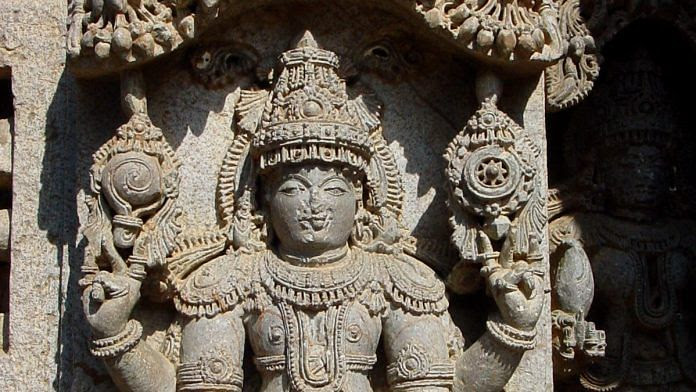 Buddha as the 9th Avatar of Vishnu. Keshava Temple, Somnathpur | Wikimedia Commons
Buddha as the 9th Avatar of Vishnu. Keshava Temple, Somnathpur | Wikimedia CommonsThe absorptive capacity of Hinduism is displayed in the Puranas, which created pantheons that brought together numerous gods and goddesses who were initially foci of independent worship. The incorporation of the Buddha as an avatara (incarnation) of Vishnu is often cited as an example of the syncretic nature of Hinduism. The question is: what sort of incorporation was it? The Puranic description of the Buddha is anything but flattering. He is supposed to delude the wicked in the Kali age and to pave the way for the arrival of the Kalki avatara. The early Bengal Upapuranas say many negative things about Buddhists; they describe them as symbols of evil, defiling, and to be avoided. Even dreaming about them is inauspicious. The later Upapuranas offer a more positive image, describing the Buddha as an embodiment of peace and beauty, and connecting him with the compassionate aim of ending animal sacrifices. Nevertheless, in spite of being recognized as an avatara, the Buddha was never worshipped in Vishnu temples.
Incorporative and subordinating strategies were not only adopted by the Vaishnavas; they were also adopted by the Buddhists, interestingly, more vis-à-vis Shaivism than Vaishnavism. Buddhist texts narrate the Trailokyavijaya episode, where Heruka, an emanation of the bodhisattva Vajrapani, gets angry with Shiva Maheshvara and destroys him by crushing him under his left foot. He then resurrects Shiva and his consort as Uma Maheshvara and gives them a new name, Bhairava–Bhairavi, and admits them into the Buddhist fold as his followers. This event is also represented visually in many Buddhist images. Religious conflict is also reflected in the many images of wrathful Buddhist Tantric deities trampling on Hindu gods and vice versa.
Inter-religious dynamics are relevant to the debate on the decline of Buddhism in India. Various factors have been suggested for this decline— the failure of Buddhism to maintain a distinct identity in relation to the Hindu sects; an alleged ‘degeneration’ brought in by increasing Tantric influences; an aggressive Brahmanism/Hinduism; and the Turkish invasions. Did Buddhism slowly fade out or was it pushed out? There is a view that it was pushed out and that this involved a great deal of very real violence.
The Mimamsaka Kumarila Bhatta is described in his hagiographies as defeating the Buddhists and establishing the supremacy of the Veda. Kumarila is said to have spent many years studying (undercover, so to speak) with a Buddhist teacher, and learning the doctrine in order to eventually refute it. He succeeded in defeating the Buddhists (and Jainas) in debate. The accounts of these debates are quite violent:
“He defeated countless Buddhists and Jainas by means of different types of arguments in the various sciences. Having cut off their heads with axes, he threw them down into numerous wooden mortars and made a powder of them by whirling around a pestle. In this way he was fearlessly carrying out the destruction of those who held evil doctrines.”
Is this metaphorical violence or is it a reflection of violent religious conflicts on the ground?
There are also references to political persecution (discussed later) of Buddhism. But Buddhism did not disappear from India. The Buddhist monasteries at Sanchi and Amaravati continued to exist till the twelfth/ thirteenth and fourteenth centuries respectively. The thirteenth century Chachnama refers to Buddhism flourishing in Sindh in the northwest. In Kashmir, the Jayendra monastery at Shrinagara and the Raja vihara at Parihasapura declined by the eleventh century, but the Ratnagupta monastery and Ratnarashmi monastery at Anupamapura flourished in the eleventh and twelfth centuries. In Bengal and Bihar, the Palas were patrons of Buddhism. Various monasteries such as Nalanda, Odantapura (near Nalanda), Vikramashila (identified with Antichak in Bhagalpur district, Bihar), and Somapuri (located at Paharpur) flourished in their kingdoms. In Orissa, remains of early medieval Buddhist stupas, monasteries, and sculptures have been found at Lalitagiri and Ratnagiri. Several Buddhist viharas were built during this period in Nepal, as well as in Ladakh, Lahul, and Spiti.
It was the Tantric form of Buddhism that flourished at most of the major monastic centres. It should be noted that some of the monasteries that were established in Tibet and in the western Himalayas during these centuries have a continuous history right down to the present. So Buddhism did not completely disappear from the subcontinent, but it did decline and was relegated to the geographical, political, and cultural margins. There is much about the history of Buddhism in early medieval India, especially the reasons for dwindling lay support and patronage, that remains obscure. But although the texts may present a dramatized, exaggerated version of events, there is no doubt that religious competition and conflict are part of the story.
It is worth noting that apart from the especially fierce Tantric deities, the iconography of many Indian deities includes weapons, and their mythology involves killing, even if those being killed are evil beings. Why is there so much violence in representations of Indian gods and goddesses and in stories of their exploits? Even if these images are interpreted metaphorically—the defeat of evil, the passions, or the ego—the stark violence in them cannot be ignored.
Upinder Singh is an Indian historian and Professor of History in Ashoka University.












